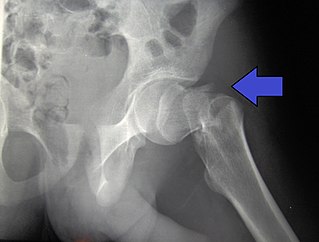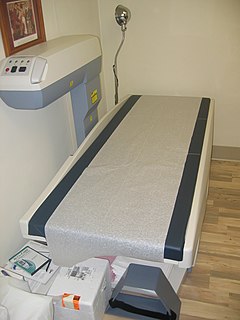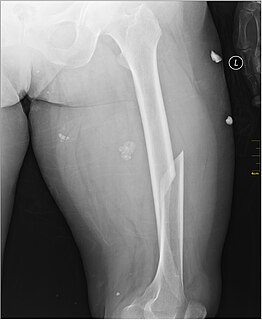Related Research Articles

Osteoporosis is a systemic skeletal disorder characterized by low bone mass, micro-architectural deterioration of bone tissue leading to bone fragility, and consequent increase in fracture risk. It is the most common reason for a broken bone among the elderly. Bones that commonly break include the vertebrae in the spine, the bones of the forearm, and the hip. Until a broken bone occurs there are typically no symptoms. Bones may weaken to such a degree that a break may occur with minor stress or spontaneously. After the broken bone heals, the person may have chronic pain and a decreased ability to carry out normal activities.

The National Institute for Health and Care Excellence (NICE) is an executive non-departmental public body of the Department of Health in England, which publishes guidelines in four areas:

Orthopaedic surgery or orthopaedics, is the branch of surgery concerned with conditions involving the musculoskeletal system. Orthopaedic surgeons use both surgical and nonsurgical means to treat musculoskeletal trauma, spine diseases, sports injuries, degenerative diseases, infections, tumors, and congenital disorders.
The National Institute of Arthritis and Musculoskeletal and Skin Diseases (NIAMS) is one of the institutes and centers that make up the National Institutes of Health, an agency of the United States Department of Health and Human Services (HHS).

Teriparatide is a form of parathyroid hormone consisting of the first (N-terminus) 34 amino acids, which is the bioactive portion of the hormone. It is an effective anabolic agent used in the treatment of some forms of osteoporosis. It is also occasionally used off-label to speed fracture healing. Teriparatide is identical to a portion of human parathyroid hormone (PTH) and intermittent use activates osteoblasts more than osteoclasts, which leads to an overall increase in bone.

A hip fracture is a break that occurs in the upper part of the femur. Symptoms may include pain around the hip, particularly with movement, and shortening of the leg. Usually the person cannot walk.
Clinical audit is a process that has been defined as a quality improvement process that seeks to improve patient care and outcomes through systematic review of care against explicit criteria and the implementation of change

Osteopenia, preferably known as "low bone mass" or "low bone density", is a condition in which bone mineral density is low. Because their bones are weaker, people with osteopenia may have a higher risk of fractures, and some people may go on to develop osteoporosis. In 2010, 43 million older adults in the US had osteopenia. Unlike osteoporosis, osteopenia does not usually cause symptoms, and losing bone density in itself does not cause pain.

The Royal National Orthopaedic Hospital (RNOH) is a specialist orthopaedic hospital located in the London Borough of Harrow, United Kingdom, and a part of Royal National Orthopaedic Hospital NHS Trust. It provides the most comprehensive range of neuro-musculoskeletal health care in the UK, including acute spinal injury, complex bone tumour treatment, orthopaedic medicine and specialist rehabilitation for chronic back pain. The RNOH is a major teaching centre and around 20% of orthopaedic surgeons in the UK receive training there.

Bone density, or bone mineral density (BMD), is the amount of bone mineral in bone tissue. The concept is of mass of mineral per volume of bone, although clinically it is measured by proxy according to optical density per square centimetre of bone surface upon imaging. Bone density measurement is used in clinical medicine as an indirect indicator of osteoporosis and fracture risk. It is measured by a procedure called densitometry, often performed in the radiology or nuclear medicine departments of hospitals or clinics. The measurement is painless and non-invasive and involves low radiation exposure. Measurements are most commonly made over the lumbar spine and over the upper part of the hip. The forearm may be scanned if the hip and lumbar spine are not accessible.
Senile osteoporosis has been recently recognized as a geriatric syndrome with a particular pathophysiology. There are different classification of osteoporosis: primary, in which bone loss is a result of aging and secondary, in which bone loss occurs from various clinical and lifestyle factors. Primary, or involuntary osteoporosis, can further be classified into Type I or Type II. Type I refers to postmenopausal osteoporosis and is caused by the deficiency of estrogen. While senile osteoporosis is categorized as an involuntary, Type II, and primary osteoporosis, which affects both men and women over the age of 70 years. It is accompanied by vitamin D deficiency, body's failure to absorb calcium, and increased parathyroid hormone.

The Royal Osteoporosis Society (ROS), formerly the National Osteoporosis Society, established in 1986, is the only UK-wide charity dedicated to improving the prevention, diagnosis and treatment of osteoporosis. It is based in Camerton, Somerset, England.
The Healthcare Quality Improvement Partnership (HQIP) was established in April 2008 to promote quality in UK health services, by increasing the impact that clinical audit has on healthcare quality in England and Wales. It is led by a consortium of the Academy of Medical Royal Colleges, Royal College of Nursing and National Voices.
Professor Derek McMinn is a British orthopaedic surgeon and inventor who practises in Birmingham, United Kingdom at the BMI Edgbaston Hospital. Prof. McMinn developed the first successful modern metal-on-metal hip resurfacing and the instrumentation and surgical technique to implant it. Hip resurfacing is a bone-conserving, less invasive alternative to total hip replacement (THR) for young patients, markedly improves the health-related quality of life measures and currently makes up around a tenth of all hip arthroplasty procedures performed in the United Kingdom. McMinn is also the inventor of several other prostheses for the hip and knee.

A femoral fracture is a bone fracture that involves the femur. They are typically sustained in high-impact trauma, such as car crashes, due to the large amount of force needed to break the bone. Fractures of the diaphysis, or middle of the femur, are managed differently from those at the head, neck, and trochanter
John Chalmers is a Scottish orthopaedic surgeon.
The trabecular bone score is a measure of bone texture correlated with bone microarchitecture and a marker for the risk of osteoporosis. Introduced in 2008, its main projected use is alongside measures of bone density in better predicting fracture risk in people with metabolic bone problems.
The Oxford Hip Score (OHS) is a standard patient-reported outcome (PRO) measure, or PROM, developed to assess function and pain in patients undergoing total hip replacement (THR) surgery, particularly in the context of clinical trials. The OHS has also been used for the assessment of patient outcomes, including physical therapy, and use of joint supplements(disease specific and general health measure are two other outcome measures)
The British Orthopaedic Association is a professional association in Britain for doctors who specialize in orthopaedic surgery.
Sarah Elizabeth Lamb is the Mireille Gillings Professor for Health Innovation and the Associate Dean of Research at the University of Exeter. She is also an Honorary Departmental Professor at the Nuffield Department of Medicine, University of Oxford and the Director of the Oxford Clinical Trials Research Unit.
References
- ↑ "BOA Blue Book". Archived from the original on 14 June 2014. Retrieved 14 September 2014.CS1 maint: discouraged parameter (link)
- ↑ "NICE CG 124" . Retrieved 14 September 2014.CS1 maint: discouraged parameter (link)